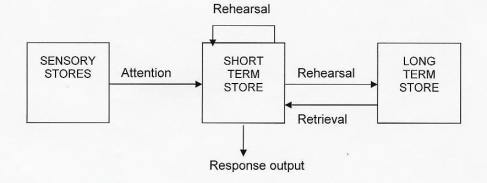Akinson and Shiffrin said that memory was split in to three different stores, firstly the Sensory Memory Store, secondly the short-term memory and thirdly the long-term memory.They said that each store had a certain function in terms of our memory and storing and recalling information. Information is rehearsed in the STM and if rehearsed enough, is then transferred to the LTM. Information is recalled from the LTM and passes back through the STM.
The information that comes from our senses is stored in the sensory store and the model says that there are specific and separate stores for each sense. This store is only brief (1/4 – 1/2 second) and most of the information would be lost here as only the information that is relevant or important to us would be passed on to the STM. Explaining the first step in remembering something-Attention. The memory here is lost by decay.
Once information is in the STM store it is then rehearsed, and if rehearsed well enough, it will be passed in to the LTM. The short term store has a capacity of 7+/-2 and can hold the information for up to 18 seconds. This is said to be a very fragile part of the memory and information can be lost through decay or displacement. However, the long term memory store is unlimited and information will be held for a lifetime. The only way it could be lost is through decay or interference.
Attention
This is needed to pass information from the senses to the STM. Most information that reaches the sensory store is not passed on because it is not relevant to us, meaning only relevant or interesting information will be passed on to the STM store.99% of information is lost at this point.
Rehearsal
This is needed to transfer information from STM to LTM. We can rehearse information out loud like a child would rehearse there times tables or in our heads. This is a crucial part of the model and it depends on how well the information is rehearsed to how well it will be remembered.
An alternative to rehearsal would be something like chunking or relating the information to a colour or image. There are different techniques to remembering information, but it depends on how you learn personally to what technique you use.
Reworking – putting information in your own words or talking about it with someone else.
Method of loci – when trying to remember a list of items, linking each with a familiar place or route.
Imagery – by creating an image of something you want to remember, you elaborate on it and encode it visually (e.g. a mind map).
Strengths
-The multi-store model has majorly influential research that is still used today.
-It is supported by new technologies such as PET scans, that also show the existence of different stores in memory.
-The role of importance shows why people remember some things more than others
Weaknesses
-The model is very over simplified and does not really show the complexity of memory.
-The model emphasises rehearsal when transferring information from STM to LTM, however a study by Craik and Lockhart found that items are much better remembered when they are processed in other ways.
-Most of the research was done in a laboratory and is artificial the means it doesn’t show memory in everyday life.







